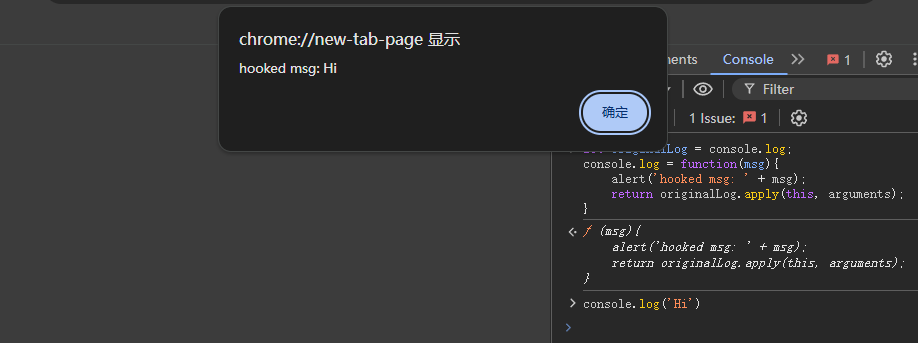JS Hook
JS 函数钩子
简单钩子
下面是一个简单的函数钩子,为 console.log 添加钩子,劫持 log 消息。
let originalLog = console.log;
console.log = function(msg){
alert('hooked msg: ' + msg);
return originalLog.apply(this, arguments);
}
console.log('Hi');
执行以上代码,console.log 已经被劫持了,在控制台输出 Hi 之前出现弹窗,点击确定之后控制台才输出 Hi

钩子封装
基于以上函数钩子的原理,将其封装成类,统一管理钩子的挂载、删除、获取和重置。
class Hook {
constructor() {
this.hooks = [];
}
get(object, funcName) {
return this.hooks.find(hook => hook.object === object && hook.funcName === funcName);
}
set(object, funcName, before, after) {
let hook = this.get(object, funcName);
if (hook) {
hook.before = before;
hook.after = after;
return;
}
let originalFunc = object[funcName];
hook = { object, funcName, originalFunc, before, after };
this.hooks.push(hook);
object[funcName] = function () {
let newArgs;
if (typeof hook.before === "function") {
newArgs = hook.before.apply(this, arguments);
}
let result = originalFunc.apply(this, newArgs || arguments);
if (typeof hook.after === "function") {
hook.after.apply(this, newArgs || arguments);
}
return result;
};
}
unset(object, funcName) {
let hook = this.get(object, funcName);
if (hook) {
object[funcName] = hook.originalFunc;
return this.hooks.splice(this.hooks.indexOf(hook), 1)[0];
}
return false;
}
reset() {
this.hooks.forEach(hook => {
hook.object[hook.funcName] = hook.originalFunc;
});
this.hooks = [];
}
}
用法:
let hook = new Hook();
hook.set(
console,
"log",
function () {
alert(`[Before] ${arguments[0]}`);
arguments[0] = `${arguments[0]} (hooked)`;
return arguments;
},
function (msg) {
alert(`[After] ${msg}`);
}
);
console.log("Hello");
hook.unset(console, "log");
console.log("Hello");
执行过程:
成功劫持到 console.log 的参数,在控制台输出 Hello 之前出现弹窗

点击确定后控制台输出被劫持过的 Hello,之后 alert 弹窗显示劫持过的 Hello。

点击确定后钩子被取消,控制台正常输出 Hello

Loading Comments...